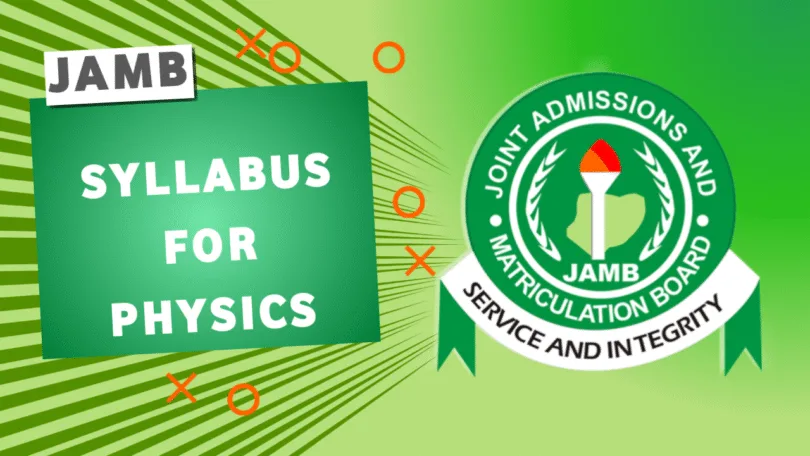JAMB Syllabus for Physics 2026/2027 is now available for all candidates taking physics in the upcoming UTME. If you’re among this set of candidates, then this is the right page you should be.
Welcome to UTME2026.COM! This article will specifically provide you with the released JAMB Physics Syllabus that will be used for the JAMB 2026. All you need to do is read, comprehend and take actions as seen while reading this article and you’ll already be ok your way to a good JAMB score in your Physics subject and others too. Let’s not delay and get started right away.
JAMB Physics Syllabus Overview
| Title | Detail |
|---|---|
| Exam Type | UTME |
| Exam Session | 2026/2027 |
| Syllabus Subject | Physics |
| File Format | |
| File Size | 250KB |
Why Do You Need JAMB Syllabus for Physics?
You can’t actually try to know the reason why you need the JAMB Syllabus for Physics without knowing what JAMB Syllabus mean. JAMB Syllabus is a document created by the Joint Admissions and Matriculation Board (JAMB). This document contains the carefully selected topics and grouped in a systematic way to help candidates make use of it easily while studying.
There are reasons why you need the JAMB syllabus specially for physics and below are some of the reasons:
- It points you towards what to study and what not to study
- It contains the key topics, focus areas and main question corner that’s more relevant with JAMB questions
- It narrows your reading and give you key focus and areas to concentrate
- It corresponds with the topics in the JAMB recommended textbooks for physics
- It serves as the guide all candidates need to study effectively and not out of what JAMB will set questions from
JAMB Syllabus for Physics 2026/2027
Clean, exam-focused breakdown of topics and subtopics (derived from the JAMB IBASS syllabus).
| S/N | Topic | Key subtopics / points to study |
|---|---|---|
| 1 | Measurement, units & errors |
|
| 2 | Scalars & vectors |
|
| 3 | Kinematics / motion |
|
| 4 | Dynamics & Newton’s laws |
|
| 5 | Work, energy & power |
|
| 6 | Circular motion & gravitation |
|
| 7 | Elasticity & simple harmonic motion |
|
| 8 | Fluids & pressure |
|
| 9 | Thermal physics |
|
| 10 | Waves & sound |
|
| 11 | Light & optics |
|
| 12 | Electricity — electrostatics |
|
| 13 | Current electricity |
|
| 14 | Magnetism & electromagnetism |
|
| 15 | Atomic & nuclear physics |
|
| 16 | Electronics & semiconductors (intro) |
|
| 17 | Practical & laboratory skills |
|
| 18 | Calculations & problem solving |
|
| 19 | Revision & exam focus |
|
How To Get The JAMB Syllabus for Physics 2026
There are two ways you can get your own copy of the JAMB Syllabus for Physics, they’re are:
- Downloading it from the JAMB main website
- Downloading it from utme2026.com
Below is how to download the JAMB syllabus for physics for the 2026/2027 UTME:
- Navigate to the JAMB Syllabus website at https://ibass.jamb.gov.ng
- Look for “Syllabus” option
- Select your subject as “Physics”
- Click on “Download Syllabus”.
- It will be saved automatically to your phone’s file manager and you can access it at anytime
- You can also download it here following the further steps below 👇
Download JAMB Physics Syllabus 2026/2027
We have also tried our possible best to reduce the work for you and upload the syllabus here for you so you don’t have to stress yourself going to the JAMB website. Kindly click on the “Download” button as seen below and it will be downloaded into your smartphone immediately.
DOWNLOAD
How Can I Use the Physics JAMB Syllabus to Read for my UTME?
There are recommended effective ways to make use of the JAMB Syllabus for Physics to study well in preparation for the UTME. Below are some of the handpicked ways by utme2026.com:
- Set a timetable
- Use JAMB Physics Past Questions
- Revise Regularly
- Note down important formulas
- Apply for online classes and offline classes too that is purely for JAMB preparation
- Solve a lot of physics exercises
- Make use of the JAMB recommended physics textbooks
- Meet people for corrections and guides
- Always use the syllabus as your guide while studying
- Be confident and study physics with strong will
JAMB Syllabus for Other Subjects
Below is a quick way to navigate to the syllabus for all other subjects offered in JAMB. Click on the “See Syllabus Here” text beside the subject to see its syllabus right away
| Subject | Syllabus Link |
|---|---|
| Arabic | See Syllabus Here |
| Use of English | See Syllabus Here |
| Mathematics | See Syllabus Here |
| Chemistry | See Syllabus Here |
| Biology | See Syllabus Here |
| Agricultural Science | See Syllabus Here |
| Economics | See Syllabus Here |
| Geography | See Syllabus Here |
| Government | See Syllabus Here |
| History | See Syllabus Here |
| Literature-in-English | See Syllabus Here |
| French | See Syllabus Here |
| Fine Art | See Syllabus Here |
| Music | See Syllabus Here |
| Animal Husbandry | See Syllabus Here |
| Igbo | See Syllabus Here |
| Hausa | See Syllabus Here |
| Yoruba | See Syllabus Here |
| Islamic Religious Studies (IRS) | See Syllabus Here |
| Christian Religious Studies (CRS) | See Syllabus Here |
| Commerce | See Syllabus Here |
| Computer Studies | See Syllabus Here |
| Home Economics | See Syllabus Here |
| Principle of Account | See Syllabus Here |
Conclusion
Being in possession of the JAMB Syllabus for Physics is going to be of a great help for you while you prepare and study for your UTME coming soon. If you love what you read on this page and you got exactly what you need, we recommend you share this resource with a loved one or a candidate like you as this will also be of huge help to them.
If you have any questions regarding the JAMB Physics Syllabus, kindly ask us using the comments section below and answers will be provided as soon as possible.





